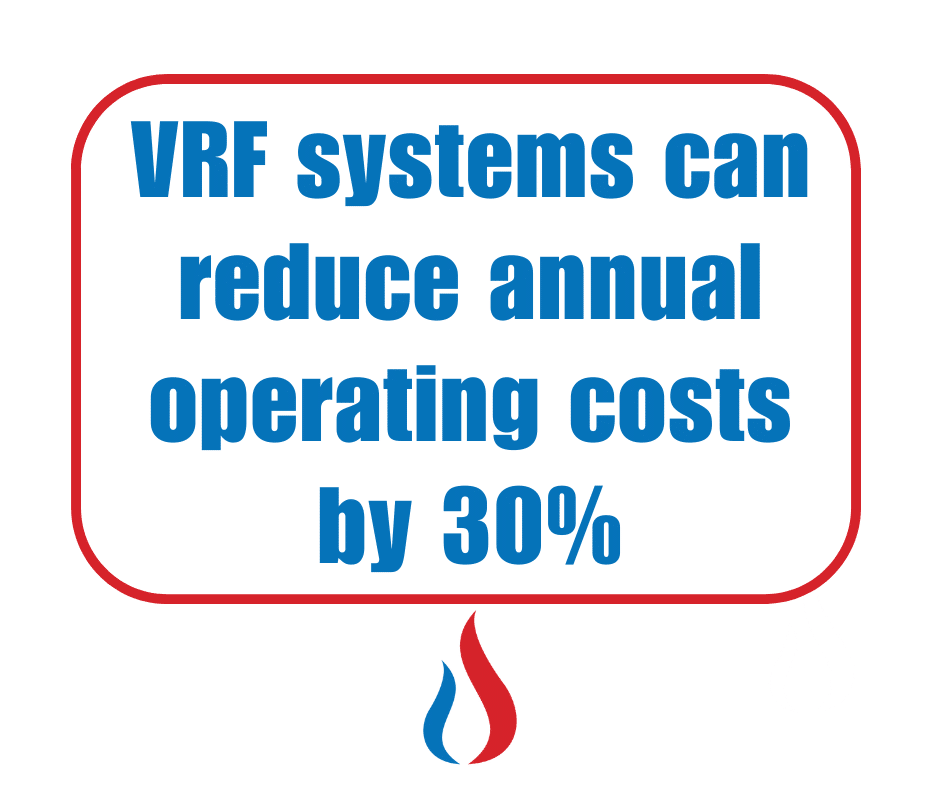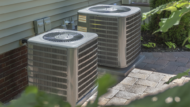In the evolving landscape of commercial HVAC solutions, Variable Refrigerant Flow (VRF) systems stand out as a beacon of innovation and tailored comfort. Offering unparalleled precision in temperature control across multiple zones, VRF technology epitomizes the shift towards customizable and efficient climate management in varied commercial settings. This blog post seeks to unpack the intricacies of VRF systems, highlighting their superiority over traditional HVAC methods through a detailed exploration and a compelling case study.
As businesses increasingly prioritize sustainability alongside operational efficiency, VRF technology is preferred for modern commercial buildings. The ability to simultaneously heat and cool different areas aligns perfectly with the diverse needs of contemporary workspaces. Through the lens of VRF’s advanced capabilities and practical application in a therapy office, we navigate the advantages and considerations that underscore the growing adoption of this cutting-edge technology.
Understanding VRF Technology
Variable Refrigerant Flow (VRF) is an advanced air conditioning technology that offers precise temperature control in multiple zones or rooms from a single system. It achieves this through a sophisticated network of indoor units connected to one or several outdoor units. This setup allows for a highly customizable climate control system, capable of simultaneously heating and cooling different areas based on individual preferences and requirements, making it an ideal solution for commercial spaces with varying temperature needs.
 The core attribute of VRF technology is its ability to regulate the amount of refrigerant flowing to each indoor unit, enhancing comfort and significantly improving energy efficiency. As a testament to its efficiency, studies have shown that VRF systems can reduce energy consumption by up to 55% compared to traditional systems (Source: U.S. Department of Energy). This makes VRF a practical choice for temperature management and an environmentally conscious one.
The core attribute of VRF technology is its ability to regulate the amount of refrigerant flowing to each indoor unit, enhancing comfort and significantly improving energy efficiency. As a testament to its efficiency, studies have shown that VRF systems can reduce energy consumption by up to 55% compared to traditional systems (Source: U.S. Department of Energy). This makes VRF a practical choice for temperature management and an environmentally conscious one.
Given its versatility and energy-saving potential, VRF technology is rapidly becoming the go-to option for commercial buildings seeking to optimize their heating and cooling systems. The system’s design flexibility means that it can be tailored to fit a facility’s specific layout and size, providing effective and efficient climate control solutions that meet each space’s unique demands.
VRF vs. Traditional HVAC
The primary distinction between VRF systems and traditional HVAC solutions lies in the realm of customization and scalability. Traditional HVAC setups, characterized by their one-size-fits-all approach, often fall short of providing the nuanced climate control that modern commercial buildings require. These systems generally operate on an all-or-nothing principle, cooling or heating entire buildings to a single set temperature, leading to inefficiencies and discomfort in spaces with diverse occupancy patterns or architectural features.
 In contrast, VRF technology shines in its ability to cater to the unique demands of different zones within a building. Each area can be individually adjusted to meet its specific climate needs, ensuring energy is not wasted on unoccupied spaces or areas requiring less cooling or heating. This zonal approach not only maximizes comfort for occupants but also contributes to significant energy savings. According to data from the Air Conditioning, Heating, and Refrigeration Institute, VRF systems can reduce annual operating costs by up to 30% compared to conventional systems.
In contrast, VRF technology shines in its ability to cater to the unique demands of different zones within a building. Each area can be individually adjusted to meet its specific climate needs, ensuring energy is not wasted on unoccupied spaces or areas requiring less cooling or heating. This zonal approach not only maximizes comfort for occupants but also contributes to significant energy savings. According to data from the Air Conditioning, Heating, and Refrigeration Institute, VRF systems can reduce annual operating costs by up to 30% compared to conventional systems.
VRF systems are equipped with advanced technology that allows for simultaneous heating and cooling in different zones – a feature traditional HVAC systems cannot match. This capability enhances user comfort and enables the system to recover heat from cooling processes and redirect it where needed, further enhancing operational efficiency. As commercial structures evolve to become more environmentally conscious and energy-efficient, the flexibility and performance advantages of VRF technology over traditional HVAC systems become increasingly apparent.
Case Study: Mini-Split Installation for a Multi-Unit Therapy Office
In Pasadena, a building manager embarked on an ambitious project to renovate a structure that houses multiple therapy offices. The challenge was multifaceted: to equip sixteen diverse rooms and three common areas with a heating and cooling system that could meet the unique demands of a therapy environment. These spaces needed to offer a quiet atmosphere conducive to therapy, allow for individual temperature control in each room to cater to the comfort of both psychologists and their patients, and adhere to a strict budgetary framework.
Understanding the complexities of this project, the building manager approached A/C Control for a viable solution. The primary concern was to find an HVAC system that not only addressed the specific requirements of a therapy office setting but also aligned with financial limitations. After thoroughly evaluating the available options, the decision was made to implement a mini-split system. This choice was driven by the need for a cost-effective yet efficient way to manage the climate across multiple individual spaces.
A/C Control proposed a 19-zone residential grade mini-split system equipped with Wi-Fi capabilities, balancing performance and cost. While this system did not offer the same level of centralized control as more sophisticated VRF systems might, it was deemed perfectly adequate for the building’s needs. Each therapy office could independently regulate its temperature, ensuring personal comfort without requiring extensive modifications or the additional costs associated with more complex installations. This solution marked a significant step forward in customizing the building’s HVAC system to fit the nuanced requirements of a therapeutic setting, prioritizing both patient comfort and budgetary considerations.
The Choice Between VRF and Mini-Splits
When faced with the decision between VRF and mini-split systems for commercial applications, key considerations come into play, notably those of initial costs and the project’s scale. Mini-splits stand out for their affordability and simplicity, appealing to smaller-scale projects or where budget constraints are paramount. This cost efficiency makes mini-splits a favored choice for projects seeking to provide targeted temperature control without the extensive infrastructure VRF systems necessitate.
Despite the allure of lower upfront costs associated with mini-splits, VRF systems offer enhanced operational efficiencies that can translate into long-term savings. According to a study by the Building Services Research and Information Association, buildings utilizing VRF technology can achieve up to a 34% reduction in annual energy costs compared to those with traditional systems. This positions VRF systems as a strategic investment for larger commercial spaces, where substantial energy savings and operational benefits offset the higher initial cost over time.
Advantages of VRF Technology for Commercial Spaces
VRF technology ushers in a new era of climate control for commercial spaces, extending far beyond traditional comfort parameters. Its dynamic adaptability allows businesses to achieve unparalleled ambient satisfaction tailored to the varying needs of distinct spaces. This technology shines in its operational silence and compact design, features that contribute to an undisturbed work environment essential for productivity and well-being in office settings.
The financial implications of adopting VRF are equally compelling. A study from ASHRAE highlights that commercial buildings employing VRF systems experience a noteworthy uptick in energy efficiency, leading to a potential decrease in operational costs. The environmental impact is minimized as well, with a significant reduction in carbon footprint, marking VRF technology as a smart business choice and a step towards sustainability in the built environment.
Forward-Looking Insights on VRF Systems
As the narrative of VRF technology unfolds, its trajectory points towards a future where these systems become an integral component of commercial building design, driven by the dual demands of environmental sustainability and operational efficiency. The adoption of VRF systems represents a technological shift and a strategic move for businesses looking to future-proof their facilities against the escalating challenges of energy management and climate control. This movement towards VRF technology demonstrates a commitment to innovation, underscoring the importance of adaptability and efficiency in the built environment.
The significance of VRF systems in the commercial sector is underscored by their potential to redefine how buildings manage their heating and cooling needs. With the global emphasis on reducing carbon footprints intensifying, and as businesses seek to align with green building standards, VRF technology offers a powerful tool that balances economic considerations with environmental responsibility. As organizations continue to navigate the complexities of operating in an increasingly eco-conscious market, the strategic relevance of investing in VRF systems cannot be overstated. These systems not only aid in achieving sustainability goals but also contribute to creating healthier, more comfortable indoor environments conducive to productivity and well-being.
Looking ahead, the importance of VRF technology to businesses lies in its potential to transform commercial spaces into energy efficiency and tailored comfort models. As commercial building requirements evolve, the flexibility, scalability, and efficiency of VRF systems make them a compelling choice for a wide range of applications. Embracing this technology equips businesses with the tools to meet future demands, ensuring that they remain competitive in a marketplace where sustainability and efficiency are increasingly valued. In this light, VRF systems emerge as more than just an HVAC solution; they represent a strategic investment in the future of commercial infrastructure.








